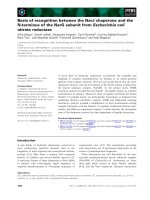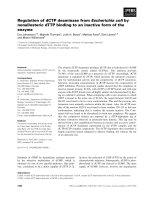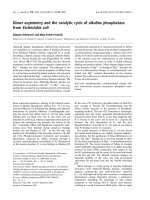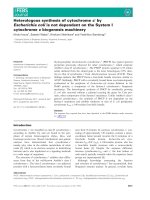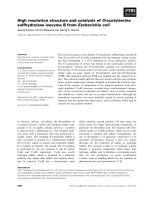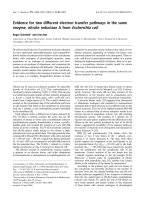Action modes of malPQ isolated from Escherichia coli K12
Bạn đang xem bản rút gọn của tài liệu. Xem và tải ngay bản đầy đủ của tài liệu tại đây (406.56 KB, 6 trang )
Vietnam Academy of Agricultural Sciences (VAAS)
General Statistic O ce, 2018. Statistical year book of
Vietnam 2017. Statistical Publishing House, Hanoi.
General Statistic O ce, 2017. Statistical year book of
Vietnam 2016. Statistical Publishing House, Hanoi.
Hung P.T., 2016. Overview on green asparagus.
Department of Sciences and Technology, Ninh
uan province. Report.
Jaramillo-Carmona S., Rodriguez-Arcos R., JiménezAraujo A., López S, Gil J., Moreno R., GuillénBejarano R., 2017. Saponin pro le of wild asparagus
species. J Food Sci., 82: 638-646.
Lu G., Jian W., Zhang J., Zhou Y., Cao J., 2008.
Suppressive e ect of silicon nutritionon Phomopsis
stem blightdevelopment. HortScience, 43: 811-817.
Maeda T, Kakuta H, Sonoda T, Motoki S, Ueno
R, Suzuki T, Oosawa K., 2005. Anti-oxidation
capacities of extracts from green, purple, and
white asparagus spears related to polyphenol
concentration. HortScience, 40: 1221-1224.
Sonoda T., Uragami A., Kaji K., 1997. Evaluation
on Asparagus o cinalis cultivars for resistance to
stem blight by using a novel inoculation method.
HortScience, 32: 1085-1086.
Xiang J., Xiang Y., Lin S., Xin D., Liu X. ,Weng L.,
Zhang M., 2014. Anticancer e ects of deproteinized
asparagus polysaccharide on hepatocellular
carcinoma in vitro and in vivo. Tumor Biol., 35:
3517-3524.
Zaw M., Naing T.A.A., Matsumoto M., 2017. First
report of stem blight of asparagus caused by
Phomopsis Asparagi in Myanmar. New diseases
report. 35: 17.
Zhang Y., Qu H., Zhao P., Wu L., Zhou J. Tang Y. Lou
S., Chen G., 2018. Transformation of Phomopsis
asparagi with green uorescent protein using
protoplasts. Can. J. Plant Pathol., 4: 254-260.
Date received: 23/11/2018
Date reviewed: 2/12/2018
Reviewer: Dr. To i u Ha
Date approved for publication: 21/12/2018
ACTION MODES OF MALQ ISOLATED FROM Escherichia coli K12
Tran Phuong Lan*1, Nguyen Minh
uy2
Abstract
e gene of malQ encoding 4-α-glucanotransferase (amylomaltase) is located in the malPQ operon of Escherichia coli
K12. e reactions of the enzyme with several types of carbohydrate were carried out under the optimal conditions in
an e ort to understand the function of MalQ enzyme in maltodextrin and glycogen metabolism of E. coli. e enzyme
catalyzed the hydrolysis of the α-1,4 glucosidic linkage of linear maltodextrins, released the reducing-end glucose of
dextrins, and it also transferred glycosyl residues onto the non-reducing end of an acceptor via a disproportionation
reaction. e smallest substrate that MalQ recognized of this reaction mode was maltose. Glucose was not the substrate
but the great acceptor for this enzyme. e enzyme performed intramolecular transglycosylation to produce the cyclic
form having degree of polymerization (DP) from DP20 to DP33 with DP24 as the main product in the reaction with
amylose substrate. ese data may explain the understanding of MalQ mechanism in vivo.
Keywords: MalQ, 4-α-glucanotransferase (amylomaltase), Escherichia coli, cycloamylose, transglycosylation
INTRODUCTION
MalQ, known as 4-α-glucanotransferase or
amylomaltase, is a member of the α-amylase family
and is widely distributed in plants and microorganisms
where it is involved in starch metabolism (Sato et al.,
2013; Critchley et al., 2001) or maltooligosaccharide
metabolism (Boos and Shuman, 1998). MalQ was rst
reported as disproportionating enzyme (D-enzyme)
in potato tubers by Peat et al. (1956) and was
reported to occur in a wide range of plant tissues
by Lin and Preiss (1988). Early studies focusing on
the biochemical properties of D-enzymes illustrated
that the multiple D-enzymes have common reaction
characteristics. MalQ appears to have different
physiological functions in microorganisms. This
enzyme was rst described by Monod and Torriani
(1948) as a maltose-inducible enzyme. Since then,
its gene has been cloned into several bacteria, and
homologous genes have been identi ed in several other
bacterial genomes. According to Kaper et al. (2005)
the enzyme catalyzes the transfer of the α-1,4-glucan
segment from one α-1,4-glucan molecule (donor)
to another α-1,4-glucan molecule (acceptor), as
expressed in the following equation:
Faculty of Agriculture and Natural Resourses, An Giang University
College of Agriculture and Applied Biology, Can o University
*
Corresponding author: Tran Phuong Lan. E-mail: /
1
2
82
Journal of Vietnam Agricultural Science and Technology - No.1(3)/2018
(α-1,4-glucan)m + (α-1,4-glucan)n
(α-1,4-glucan)m-x + (α-1,4-glucan)n + x
is is an intermolecular transglycosylation reaction
and is o en referred as a disproportionation reaction.
is enzyme also catalyzes an intramolecular glucan
transfer reaction within a single linear glucan molecule
to produce cyclic α-1,4-glucan (cycloamylose) as
follows:
(α-1,4-glucan)n
cyclic (α-1,4-glucan)x +
(α-1,4-glucan)n- x
Recently, several MalQ proteins from various
sources have been investigated, such as Arabidopsis
(Critchley et al., 2001), Chlamydomonas reinhardtii
(Buschiazzo et al., 2004), Potato (Takaha et al.,
1996), Escherichia coli ML (Palmer et al., 1976),
ermus aquaticus (Przylas et al., 2000), ermus
thermophilus (Binnema et al., 1998), Aquifex aeolicus
(Bhuiyan et al., 2003), ermotoga martima (Lee et
al., 2002), ermococcus litoralis (Jeon et al., 1997),
and ermococcus kodakaraensis (Tachibana et al.,
2000).
e MalQ encoded by malQ gene isolated
from E. coli K12 has 694 amino acid residues. Its
molecular protein weight is 72 kDa. is enzyme has
highest activity at 37°C and pH 6.5 in 50 mM sodium
acetate (Tran et al., 2011).
is study focused on clari cation of action modes of
MalQ encoded by the malQ gene from E. coli K12 as
a test of E. coli matodextrin metabolism in vitro.
MATERIALS AND METHODS
Materials
Recombinant E. coli carrying malQ gene of E. coli
mutant K12, kindly provided by Prof. W. Boos
at University of Konstanz, Germany was used to
produce MalQ. Bovine glycogen, glucose, maltose,
maltotriose and maltoheptaose were bought from
Sigma Chemical Co. (St. Louis, USA). Isoamylase
isolated from Pseudomanas amyloderamosa was
obtained from Hayashibara Biochemical Laboratory
(Okayama, Japan). Other reagents used in this study
were purchased from Sigma Chemical Co. (USA),
Merck (Germany), Junsei Chemical Co. (Tokyo,
Japan), or Showa Chemicals Inc. (Tokyo, Japan).
Methods
reached 0,6.
e IPTG was added to the nal
concentration of 0.2 mM.
e culture was then
continued to incubate for 6hrs at 25°C and the cells were
collected by centrifugation (4,000 ˟ g, 20 min, 4°C).
e cell pellet was resuspended in 100 ml of lysis
bu er [50 mM tris-HCl (pH 7.5), 300 mM NaCl,
10 mM imidazole] and sonicated over an ice batch
(VC-600, Sonics & Materials Inc., Newtown, CT, USA;
output 4, 5 min ˟ 3 times, 60% duty). e crude cell
extract was centrifuged (10,000 ˟ g, 4°C, 15 min). Ten
milliliters of the crude enzyme was applied to 2 ml of
nickel-nitrilotriacetic acid (Ni-NTA) resin (QIAGEN,
USA) packed in a Poly-Prep Chromatography
column (BIO-RAD, Hercules, CA, USA). e resin
was washed twice with 4 ml of washing bu er
[50 mM Tris-HCl (pH 7.5), 300 mM NaCl, 20 mM
imidazole]. Then 2 ml of elution buffer [50 mM
Tris-HCl (pH 7.5), 300 mM NaCl, 250 mM imidazole]
was used to allow elution of the target proteins.
The eluted target protein was concentrated by
ultrafiltration (Amicon Co., USA), and dialyzed
against 50 mM Tris-HCl bu er (pH 7.5).
Determination of protein amount and molecular mass
Protein concentration was determined by the
Bradford method (Bradford, 1976). e purity and
molecular mass of puri ed proteins were analyzed by
10% SDS-PAGE.
Enzyme reaction
Reaction modes of MalQ were carried out by the
separated reactions of the enzyme with glucose,
maltose, maltotriose, maltoheptaose and amylose
in the optimal conditions determined by Tran et al.
(2011). A er inactivation of the enzyme reaction
by boiling, the mixtures were analyzed by thin layer
chromatography (TLC) and/or high performance
anion exchange chromatography (HPAEC) to
understand the enzyme action mechnism.
in layer chromatography (TLC) analysis
TLC was conducted as Tran et al. (2014) described
with slightly modi cation. Isopropyl alcohol - ethyl
acetate - water (3 : 1 : 1, v/v/v) or n-butanol - acetic
acid - water (5 : 3 : 1, v/v/v) were used as solvent in the
TLC method.
Protein puri cation
High performance anion exchange chromatography
(HPAEC) analysis
In batch puri cation of MalQ, E. coli BL21 (DE3)
carrying the corresponding gene was cultured in
1 liter of LB broth supplemented with kanamycin
20 ml/ml at 37°C and 200 rpm until the OD600nm
e reaction mixtures were boiled for 10 min and
centrifuged at 12,000 ˟ g for 10 min, and ltered
using a membrane lter kit (0.45 mm pore diameter,
Gelman Sciences, USA). HPAEC was performed
83
Vietnam Academy of Agricultural Sciences (VAAS)
using a Dionex (Sunnyvale, CA, USA) DX-500 system
with a pulsed amperometric detector (ED40, Dionex,
USA).
e system was equipped with a CarboPac
PA-100 column (4 ˟ 250 mm, Dionex) and run with
a gradient of 0 - 0.6 M sodium acetate in 0.15 M NaOH
at a ow rate of 1.0 ml/min (Tran et al., 2015).
Time and place of the study
Matrix Assisted Laser Desorption Ionization - Time
of Flight (MALDI-TOF) mass spectrometry analysis
Intermolecular transglycosylation
e study was carried out at Seoul National University
(South Korea), An Giang University and Can o
University (Vietnam) in 2015.
RESULTS AND DISCUSSION
Molecular mass spectrum of the puri ed enzyme
was collected by MALDI-TOF Mass spectrometer
[VoyagerTM-DE (Perceptive Biosystem, Framingham,
USA)]. Sinapinic acid (3,5-dimethoxy-4 hydrony
cinnamic acid) is proper matrix for proteins or peptides
more than 10 kDa. Proper matrix concentration was
10 mg/ml, nal concentration to 0.1 ~ 5 pmol/ml.
Ten milligram of sinapicnic acid was dissolved in 1
ml of solvents containing 400 ml deionized water, 100
ml 3% TFA and 500 ml acetonitril. For the calibration
analysis, 1% bovine serum albumin (Sigma) solution
was prepared. Ten milligram of BSA was dissolved in
1 M of solvent containing 600 ml deionized water, 100
ml 3% TFA and 300 ml acetonitril. One microliter of
puri ed BBMA (0.1 to 0.01 mg/ml nal concentration)
and 1 ml of prepared matrix were mixed and dropped
on a sample plate and air dried until crystallization
occurred. en the sample plate was loaded into the
Voyager Biospectrometry Workstation and analyzed
the molecular weight of the sample at the proper
conditions (Grid voltage: 87, Grid wire voltage: 0.3,
Delayed extraction: 300 nsec, laser: 2000 etc.).
In order to characterize MalQ overexpressed in E.
coli, the action pattern of the puri ed enzyme was
determined by incubating it with glucose, maltose,
maltotriose, maltoheptaose and amylose. As shown
in Fig. 1, there was no any product in the reaction
mixture of the enzyme with glucose (Fig 1, lane G1).
However, TLC result showed that many longer chain
maltodextrins were formed in the enzyme reactions
with the other substrates (Fig 1, lane G2, G3 and
G7). To understand the e ect of substrate size on the
formation of maltodextrin, the reaction mixtures of
MalQ with maltose, maltotriose, and maltoheptaose
were further analyzed by HPAEC.
e transfer
linear products of G2, G3, and G7 substrates with
MalQ ranged DP up to approximately DP12, DP20,
and DP35, respectively (Fig. 2). It indicated that
the larger maltooligosaccharides were treated with
MalQ, the longer maltodextrins were brought about.
Consequently, maltose was the smallest substrate for
MalQ reaction. MalQ was able to catalyze the reaction
of intermolecular transglycosylation in which
the enzyme transferred a non-reducing dextrinyl
moiety onto another maltodextrin forming their
transglycosylation products (Critchley et al., 2001).
Figure 1. TLC analysis of reaction pattern of MalQ
with glucose (G1), maltose (G2), maltotriose (G3),
maltoheptaose (G7), amylose (Aml)
Figure 2. HPAEC analysis of side chain distribution
of long maltooligosaccharides formed by MalQ from
maltose (A), maltotriose (B), and maltoheptaose (C)
84
Journal of Vietnam Agricultural Science and Technology - No.1(3)/2018
TLC plate, the spots of the reaction products did not
appear due to the low sensitivity of this method and
also indicated amylose was not a preferred substrate
for intermolecular transglycosylation of MalQ.
Intermolecular transglycosylation
When amylose was incubated with MalQ, the TLC
plate also did not show any product in the reaction
mixture (Fig 1, line Aml). However, to con rm this
result and understand role of glucose, amylose was
used as a donor and reacted with 14C-labeled glucose
as an acceptor in present of MalQ. e chromatogram
in Figure 3 was visualized by the naphthol-H2SO4
method and autoradiography (Fig. 3, A and B,
respectively). e autoradiogram showed a series of
transfer short maltooligosaccharides was produced.
is result indicated that glucose was not the MalQ
substrate but able to serves as a high-quality acceptor
in the MalQ reaction. On the naphtol-H2SO4 treated
Tarada et al. (1999) improved that the reaction
between amylose and amylomaltase from ermus
aquaticus produced the cyclic form products. To see if
MalQ catalyzes the cyclization of amylose, 0.5% (w/v)
type III amylose was incubated with the enzyme in
the proper bu er, pH and temperature conditions
(Tran et al., 2011).
e result of HPAEC analysis
showed chromatogram pattern at retention time 22
to 38 min might be cyclic products (Fig. 4A). e
aliquot was incubated with β-amylase from barley
(10 U/gram of substrate) for 3 hrs at 30°C in TrisHCl pH 7.5 to con rm that cycloamylose was present
in the reaction mixture. A er enzyme treatment,
it demonstrated almost the linear glucans were
removed and a high maltose contain was produced
simultaneously (Fig. 4B).
e β-amylase-resistant
glucans were then separated by double volumes of
99,5% ethanol precipitation and analyzed again by
HPAEC. e products were eluted at retention time
for approximately 22 to 38 min, which was identical
to the elution time of cycloamylose (Fig. 4C). e
molecular weights of the β-amylase-resistant glucans
were measured using MALDI-TOF MS (Fig. 5). e
mixture of the β-amylase-resistant glucans ranged
from DP20 to 33 with DP24 as the main product of
intermolecular transglycosylation that o en referred
to as a coupling reaction of MalQ.
Figure 4. HPAEC analysis of cyclo-amylose product
(A) Reaction mixture of amylose was treated with MalQ;
(B) e reaction mixture a er β-amylase treatment;
(C) Cycloamylose products
Figure 5. MALDI-TOF MS analysis
for cyclo-amylose produced by MalQ
Figure 3. TLC analysis of reaction pattern generated
by MalQ from amylose containing a 14C-labeled
glucose. e chromatogram was the visualized using
naphtol-H2SO4 method (A) and autoradiography (B).
Lane 1: the compound of substrate before reaction;
Lane 2: the transfer products a er reaction
85
Vietnam Academy of Agricultural Sciences (VAAS)
CONCLUSIONS
e MalQ, 4-α-glucanotransferase protein of E. coli
K12, carried out the reaction of disproportionation
by intermolecular transglycosylation with maltose as
smallest substrate to produce longer maltodextrins.
However, the molecular size of maltodextrins likely
depends on the presence of appropriate acceptor
molecules. When glucose worked as an acceptor, it led
to the production of short matodextrins. e enzyme
also catalyzed the intermolecular transglycosylation
to form cycloamyloses. Both of MalQ reaction
mechanisms were displayed in Figure 6. ese results
are basic data for further study and understanding of
E. coli metabolism in vivo.
- Intermolecular transglycosylation
- Intramolecular translycosylation
Figure 6. Reaction mechanisms of MalQ
(4-α-glucanotransferase)
ACKNOWLEDGMENT
The authors thank Dr. Park Kwan Hwa - Seoul
National University for supporting fund and facilities
and Dr. Park Jong Tae for supporting technique skills
to implement this study.
REFERENCES
Bhuiyan, S. H., Kitaoka M. and Hayashi K., 2003.
A cycloamylose-forming hyperthermostable
4-α-glucanotransferase of Aquifex aeolicus expressed
in Escherichia coli. J. Mol. Catal. B. Enz., 22: 45-53.
Binnema, D. J. and Euverink G. J. W., 1998. Use
of modi ed starch as an agent for forming a
thermoreversible gel. Patent application WO9815347.
Boos, W. and Shuman H., 1998. Maltose/maltodextrin
system of Escherichia coli: transport, metabolism,
and regulation. Microbiol. Mol. Biol. Rev., 62 (1):
204-229.
Bradford, M., 1976. A rapid and sensitive method for
the quantitation of microgram quantities of protein
utilizing the principle of protein-dye binding. Anal.
Biochem, 72 (1-2): 248-254.
86
Buschiazzo, A., Ugalde J. E., Guerin M. E, Shepard
W., Ugalde R. A. and Alzari P. M., 2004. Crystal
structure of glycogen synthase: homologous enzymes
catalyze glycogen synthesis and degradation.
e
EMBO J., 23: 3196-3205.
Critchley, J. H., Zeeman S. C., Takaha T., Smith
A. M. and Smith S. M., 2001. A critical role for
disproportionating enzyme in starch breakdown is
revealed by a knock-out mutation in Arabidopsis.
Plant. J., 26: 89-100.
Jeon, B. S., Taguchi H., Sakai H., Ohshima T.,
Wakagi T. and Matsuzawa H., 1997. 4-Alphaglucanotransferase from the hyperthermophilic
archaeon ermococcus litoralis-enzyme puri cation
and characterization, and gene cloning, sequencing
and expression in Escherichia coli. Eur. J. Biochem,
248 (1): 171-178.
Kaper, T., Talik B., Ettema T. J., Bos H., van der
Maarel M. J. E. C. and Dijkhuizen L., 2005.
Amylomaltase of Pyrobaculum aerophilum IM2
produces thermoreversible starch gels. Appl. Environ.
Microbiol, 71: 5098-5106.
Lee, H. S, Auh J. H., Yoon H. G., Kim M. J., Park J.
H., Hong S. S., Kang M. H., Kim T. J., Moon T. W.,
Kim J.W. and Park K. H., 2002. Cooperative action
of alpha-glucanotransferase and maltogenic amylase
for an improved process of isomaltooligosaccharide
(IMO) production. J. Agric. Food Chem., 50(10):
2812-2817.
Lin, T. P. and Preiss J., 1988. Characterization of
D-enzyme (4-α-glucanotransferase) in Arabidopsis
leaf. Plant Physiol. (Bethesda), 86 (1): 260-265.
O’Neill E.C., Stevenson C.E., Tantanarat K., L atousakis
D., Donaldson M.I., Rejzek M., Nepogodiev
S.A., Limpaseni T., Field R.A., Lawson D.M., Peat
S., Whelan W. J. and Rees W. R., 1915. Structural
dissection of maltodextrin disproportionation cycle
of the arabidopsis plastidial disproportionation
enzyme 1 (DPE1). J. Biol. Chem., 290 (50):
29834-29853.
Palmer, T. N., Ryman B. E. and Whelan W. J., 1976.
e action pattern of amylomaltase from Escherichia
coli. Eur. J. Biochem, 69 (1): 105-115.
Peat, S., Whelan W. J. and Rees. W. R., 1956.
e
enzymic synthesis and degradation of starch: the
disproportionating enzyme of potato. J. Chem. Soc.
44-53.
Przylas I., Tomoo K., Terada Y., Takaha T., Fujii
K., Saenger W. and Sträter N., 2000. Crystal
structure amylomatase from
ermus aquaticus,
a glycosyltransferase catalysing the production of
large cyclic glucans. J. Mol. Biol., 296 (3): 873-886.
Sato Y., Okamoto-Shibayama K. and Azuma T., 2013.
e malQ gene is essential for starch matebolism
Journal of Vietnam Agricultural Science and Technology - No.1(3)/2018
in Streptococcus mutans. J. Oral. Microbiol, 5:
21285-21293.
Tachibana, Y., Takeshi T., Shinsuke F., Masahiro T.
and Tadayuki I., 2000. Acceptor specificity
of 4-α-glucanotransferase from Pyrococcus
kodakaraensis KOD1, and synthesis of cycloamylose.
J. Biosci. Bioeng, 90 (4): 406-409.
Takaha, T., Yanase M., Okada S. and Smith S.M.,
1996. Potato D-enzyme catalyzes the cyclization
of amylose to produce cycloamylose, a novel cyclic
glucan. J. Biol. Chem., 271 (6): 2902-2908.
Tarada, Y., Fujii K, Takaha T. and Okada S., 1999.
ermus aquaticus ATCC 33923 amylomaltase gene
cloning and expression and enzyme characterization:
production of cycloamylose. Appl. Environ.
Microbiol, 65 (3): 910-915.
Tran, P.L., Park, K.H., Park J.T., 2011. Cloning malQ
from Escherichia coli K12 and determination of
optimal reaction condition of MalQ. J. Sci. - Can o
University, 17a: 173-180 (in Vietnamese).
Tran, P.L., Lee, J.S., Park, K.H., 2014. Experimental
evidence for a 9-binding substrate of Bacillus
licheniformis thermostable α-amylase. FEBS Lett.,
588: 620-624.
Tran, P.L., Nguyen, D.H.D., Do, V.H., Kim, Y.L.,
Park, S.H., Yoo, S.H., Lee, S. and Kim, Y.R., 2015.
Physicochemical properties of native and partially
gelatinized high-amylose jacfruit (Artocarpus
heterophyllus Lam.) seed starch. LWT Food Sci.
Technol., 62: 1091-1098.
Monod and Torriani A.M., 1948. Synthèse d’un
polysaccharide de type amidon aux dèpens du
maltose, en prèsence d’un extrait enzymatique
d’origine bacterienne. Comptes Rendus de l’ Acadèmie
des Sciences, 277: 240-242.
Date received: 1/10/2018
Date reviewed: 15/10/2018
Reviewer: Assoc. Prof. Dr. Nguyen Hoang Anh
Date approved for publication: 25/10/2018
EFFICIENT USE OF CROP RESIDUES FOR PRODUCING ENERGY
AND ENHANCING SOIL CARBON SEQUESTRATION
AS CLIMATE SMART PRACTICES IN RURAL AREAS OF VIETNAM
Mai Van Trinh1, Bui i Phuong Loan1,
Nguyen Van iet1, Cao Huong Giang*1
Abstract
is article presents results of research on the e cient use of crop residues in energy production and land carbon
xation in Ha Tinh, Yen Bai and Bac Lieu. MHH-IAE 003 was a product designed and tested by IAE, suitable for
many kinds of materials such as: rice husk, sawdust, peanut husk, maize corn, wood chips. Compared to similar
stoves, MHH-IAE 003 stove was more e ective on heat management and air pollution reduction. Biochar get
high organic carbon and CEC. e biochar was applied to soil, combined with changes in mineral fertilizers in
experiments in Ha Tinh, Yen Bai, Bac Lieu. e experiment in Yen Bai showed that use of 1.5 tons of biochar per
hectare increased corn yield and decreased 20% of chemical fertilizer. Rice in Bac Lieu also reached the similar
results. e peanut experiment sites in Ha Tinh, with the same amount of NPK applied but the greater amount of
biochar also got more productive than the other formulas. In 3 experiments, biochar method led to increase the
amount of organic matter. Cation exchange capacity (CEC) was proportional to the amount of organic matter.
Apply biochar increased soil carbon higher than convention. is research has initially led to a successful approach
to changing farmer’s crop residue treatment methods, using with a new, more e cient and sustainable way of
reducing greenhouse gas emissions.
Keywords: Gasi er, biochar, crop residues, Yen Bai, Ha Tinh, Bac Lieu
INTRODUCTION
Agricultural activity is known to be the sector
most a ected from climate change, is also a large
contributor of greenhouse gas emissions (14%).
Factors regulating the GHGs emissions from
1
*
agricultural activities are many, among others, over
use of chemical fertilizer, over irrigation, etc. Burning
crop residues in the elds is part of the problem,
will be increased in the future as modern cooking
facilities replace crop residues cooking devices. While
Institute for Agriculture Environment (IAE), VAAS
Corresponding author: Cao Huong Giang. Email:
87
